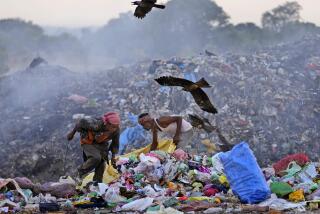80,000 Pullers Work Foul Streets : Rickshaw Passengers Still Riding High in Calcutta
- Share via
CALCUTTA — In two years, Shekh Mohammed Enus said, he hopes to retire. For more than 20 years he has strained and slogged through the foul streets of Calcutta with his wooden rickshaw, ferrying passengers too feeble or too fat or too squeamish to walk.
This year, Enus’ oldest son has become a rickshaw puller like his father. In two years he will know the streets well enough to earn the rupees needed to take over support of the extended family. Enus can retire then, weary but still alive. That in itself will be a minor miracle for this man who has walked barefoot thousands of miles pulling a two-wheel, 180-pound rickshaw with its human cargo.
Sometimes, that cargo has been an entire family--a couple and their three children and perhaps a mother-in-law, sitting high and mighty on the plastic-covered seat of the rickshaw.
India is a land of great compassions and charity. It is also a land of stunning cruelties. For a Westerner raised in a more egalitarian setting, the cruelties are sometimes easier to understand than the indifference to physical humiliation of one person by another, as symbolized by the man-powered rickshaw.
In Calcutta, for example, there is little or no social stigma attached to riding in a carriage pulled by another human being.
“Compared with being crushed and jostled on a bus, clinging to the door of a tram or stumbling along a broken pavement, rickshaw riding is luxurious,” a British engineering professor, T.H. Thomas, wrote in a 1981 study. “The view is good; conversation between riders is easy; the puller may be instructed to hurry, dawdle or make impromptu stops at a rider’s will. Fine clothes will not be crushed or dirtied.”
Calcutta is the last major city in the world to have significant numbers of man-pulled rickshaws. Eighty thousand men, mostly Muslims from the poor state of Bihar, toil at this anachronistic occupation.
The rickshaw was invented by a missionary in Japan in 1871 but it has long since disappeared there. China banned the rickshaw in 1949 as a cruel and exploitative occupation. Even Bangladesh, the miserably poor country east of Calcutta, does not permit one human being to pull another between the shafts of a rickshaw.
Introduced by Chinese
Yet rickshaws persist, and even thrive in Calcutta, where they were introduced in 1914 by Chinese immigrants.
Actually, they are a relatively modern mode of transport here. During the Victorian era, in which Calcutta was transformed into an Asian capital for the British empire, 10,000 palanquin (litter) bearers worked in Calcutta, carrying British and rich Indian sahibs in compartments supported on the shoulders of two or four men.
There are no more palanquins in Calcutta today, but rickshaws are as much a part of the city as the Howrah Bridge over the Ganges or the giant temple to the Goddess Kali or the home for the dying run by Mother Teresa and the Sisters of Charity.
One reason is that during the monsoon season, June through August, rickshaws are often the only transportation moving through rain-flooded streets. And in the monsoon season, rickshaw pullers triple their rates.
“As flood levels rise, so do the importance and fares of rickshaws,” Prof. Thomas wrote.
Embarrassment to Government
Despite their usefulness during the monsoon, the rickshaws remain an embarrassment to the Communist government of the surrounding state of West Bengal, a symbol of its failure to bring progress to this city.
Repeated efforts by the government to ban rickshaws here, or at least to limit their number, have obviously failed. Some city officials here sadly admit that the numbers of rickshaws on Calcutta streets may actually be increasing.
Only 6,000 rickshaws are licensed to operate in Calcutta, Police Sgt. Shyamal Chakravarty said, “but you will see more than 30,000 plying our streets.”
Rickshaw owners--they include many police constables, Chakravarty admitted--run several rickshaws under the same license, making sure that their vehicles operate in different parts of the city. If they are caught by police and their rickshaws confiscated, it is not very expensive to buy a replacement, and they can recoup their investment in less than a year. Some rickshaw owners have several hundred vehicles.
With very few exceptions, the rickshaw puller leases his rickshaw from an owner at a rate of about seven rupees (55 cents) a day.
A typical rickshaw puller is a Muslim from Bihar state. Usually he will leave his family in Bihar and come to Calcutta for six months at a time. He sleeps on the floor of a room that he shares with 25 or more other rickshaw pullers.
May Earn $2 a Day
If he is lucky and works hard, he will earn about 25 rupees ($2) a day. After he has paid his rent to the rickshaw owner and spent money for food and housing, he might have 10 rupees (about 75 cents) to send to his family.
To a Westerner this may seem a paltry sum, but to a poor man from Bihar, where farm workers are often paid in grain instead of cash, it is a step up. “I was paid five kilograms of grain a day,” said Mohammed Saku, 25, a rickshaw puller from Bihar who came to Calcutta only a few months ago. “I know that this is not a good job. But I had six mouths to feed and five kilograms of grain was not enough.”
In India’s complicated, caste-dominated society, there are many jobs considered much worse than rickshaw puller: working with leather, for example, or removing human waste from private homes or handling the remains of dead animals.
And, according to a study on the subject by Unnayan, a Calcutta social work organization, “rickshaw pulling is a socially acceptable activity insofar as it is considered no defect in a prospective husband.”
That is significant, since marriage is a key measure of status in Indian society, even in the supposedly casteless Muslim community.
Few Like Their Jobs
Still, there are few rickshaw wallahs who will say that they like their jobs.
“I hate this work but I can’t find anything else,” said Mohammed Khartali, 35, who came to Calcutta from Bihar after a mica plant where he worked closed.
The biggest challenge to a rickshaw puller is the constant threat to his health. Rickshaw pulling is hard and dangerous. During the monsoon rains, when the streets become rivers, inexperienced rickshaw men have been known to fall into manholes uncovered by the city to help drain the streets. During dry times, many others are hit by buses and cars vying for space on the congested roads.
Although one famous Calcutta rickshaw puller named Ramrit Paswan recently retired at the age of 80 after toiling between the wooden shafts for 60 years, most pullers do not survive 10 years. If they do not die on the job, their lungs collapse or their legs finally give out under the strain.
Unlike the many other rickshaw pullers who succumb to disease or maiming injury after only a year or two as a human horse, Shekh Mohammed Enus, the man who hopes to retire in two years, said he has been able to survive two decades pulling a rickshaw because he spends a little more money on his body each day than the others.
Balanced Diet the Key
The key to longevity, said Enus, a ragged figure no more than 4 feet, 8 inches tall clad in a cotton dhoti tied like a diaper around his groin, is to eat a balanced diet that includes an occasional piece of meat or fish. When he speaks of food, Enus can make a grizzle of mutton sound like filet mignon and a stinking piece of Ganges River fish sound like truite bleu.
Whereas other pullers might spend only eight rupees (about 60 cents) or even as little as five rupees (40 cents) each day on food, Enus said he spends 10 rupees (75 cents).
This means he sends a little less money back to his family in Bihar. But the extra money allows him to supplement his normal meals of flat bread and lentils with an occasional shred of fish or mutton.
“I have to maintain myself,” Enus explained, speaking as a mechanic might of the need for a regular tuneup.
After all, he knows what it takes to keep his tiny, sinewy human engine running--10 rupees a day, 75 cents.
More to Read
Sign up for Essential California
The most important California stories and recommendations in your inbox every morning.
You may occasionally receive promotional content from the Los Angeles Times.










